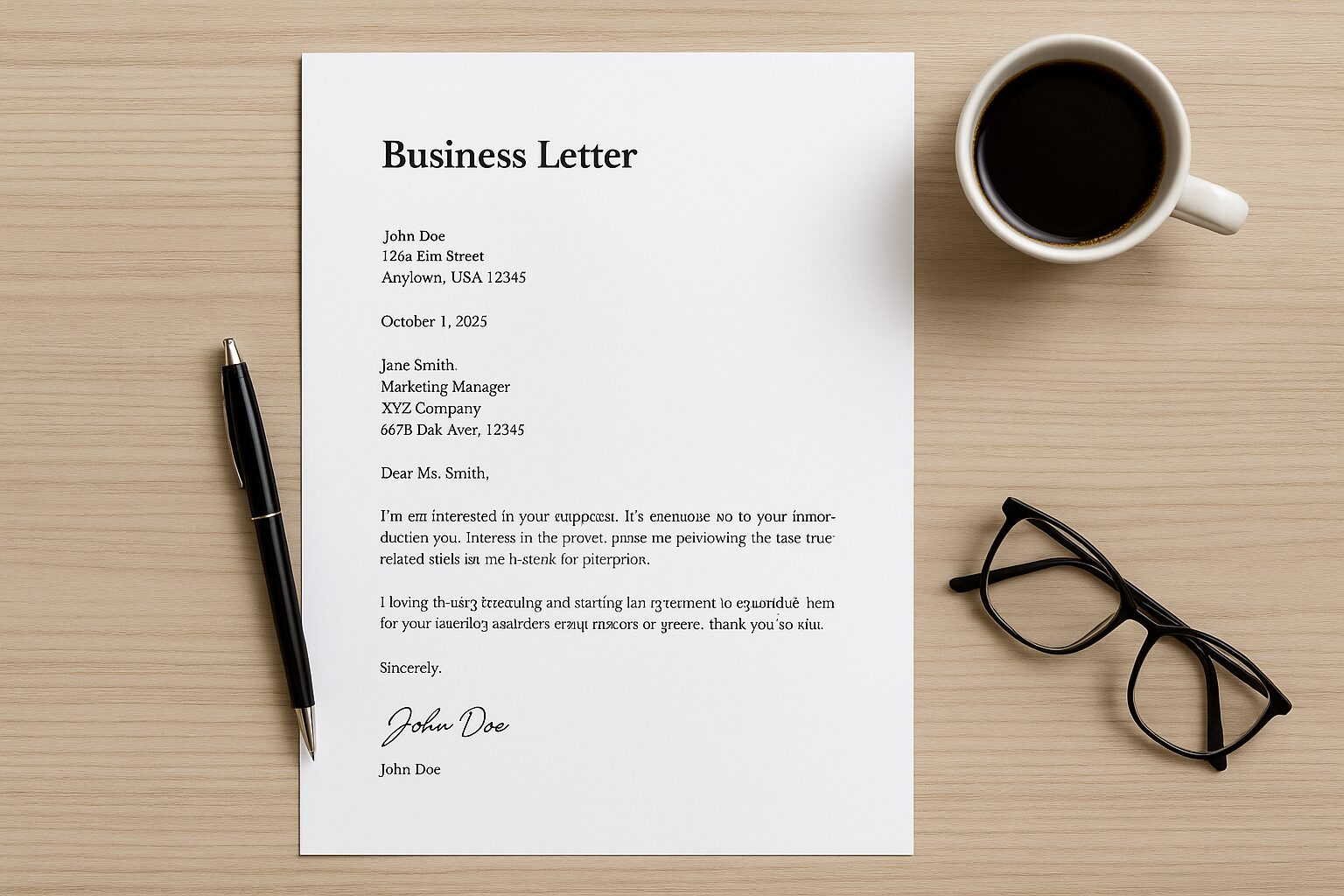In today’s professional world, clear and effective communication is more important than ever. Whether you’re reaching out to a potential employer, a client, or a business partner, a well-structured business letter can make a lasting impression. Following a proper business letter format ensures your message is understood, respected, and taken seriously.
This guide will walk you step-by-step through writing effective business letters, from understanding the types of letters to formatting, content, and common examples. By the end of this article, you’ll know how to create professional letters that convey your message clearly and professionally.
Understanding Business Letters
What is a Business Letter?
A business letter is a formal document used to communicate professionally with individuals, organizations, or institutions. Unlike emails or casual messages, business letters follow a structured format, ensuring clarity and professionalism.
Types of Business Letters
- Formal Letters – Used for official communications, such as job applications, legal notices, or corporate correspondence.
- Semi-Formal Letters – Address colleagues or business partners with a respectful but slightly casual tone.
- Informal Letters – Used occasionally within companies, like messages to team members or internal communications.
Key Elements Common to All Business Letters
- Clear sender and recipient details
- Proper greeting and salutation
- Structured body content
- Appropriate closing and signature
- Optional enclosures or references
By including these elements, your letter will be organized and professional.
Standard Business Letter Format
Using a standardized format ensures your letter is readable and professional. Below are the main sections of a business letter format:
1. Header: Sender’s Details and Date
Include your name, address, phone number, email, and the date at the top. This helps the recipient identify you and respond efficiently.
2. Inside Address: Recipient’s Details
Write the recipient’s name, title, company, and address. Double-check spellings and titles for professionalism.
3. Salutation/Greeting
Start with “Dear [Name],” or “To Whom It May Concern,” for formal letters. Avoid casual greetings unless appropriate.
4. Body of the Letter
Organize the body into:
- Introduction – State the purpose of your letter.
- Main Content – Provide details, examples, or requests clearly and concisely.
- Conclusion – Summarize your message and indicate any follow-up actions.
5. Closing
Use formal closings like “Sincerely,” “Best regards,” or “Yours faithfully.”
6. Signature
Sign your name manually for printed letters, or type it for emails, followed by your title if applicable.
7. Optional Elements
Include enclosures (Encl.), carbon copies (CC), or references at the bottom if necessary.
Step-by-Step Guide to Writing a Business Letter
Step 1: Identify the Purpose of Your Letter
Clearly define why you are writing. Are you requesting information, applying for a job, or lodging a complaint? Knowing the purpose shapes the tone and content.
Step 2: Gather Necessary Information
Collect recipient details, supporting documents, and facts before drafting your letter. Accuracy builds credibility.
Step 3: Choose the Appropriate Business Letter Format
Select formal, semi-formal, or informal depending on the context. Using the right format ensures the letter is received well.
Step 4: Write a Professional Opening
Start with a polite introduction and clearly state the purpose. Avoid vague openings.
Step 5: Develop the Body Clearly and Concisely
Use short paragraphs and bullet points if needed. Keep language professional and avoid unnecessary jargon.
Step 6: Conclude with a Strong Closing Statement
Summarize key points and indicate any required actions. End with a courteous statement like “Thank you for your time and consideration.”
Step 7: Review, Edit, and Proofread
Check spelling, grammar, formatting, and tone. A polished letter reflects professionalism.
Visual Example of Business Letter Format:
Source: Example.com
Tips for Writing an Effective Business Letter
- Use formal language and professional tone – Avoid slang or casual phrases.
- Keep the letter clear and concise – Stick to relevant points.
- Avoid common mistakes – Check spelling, grammar, and punctuation.
- Tailor content to the recipient – Customize letters for individuals or companies to make them more effective.
Common Business Letter Examples
| Type of Letter | Purpose / Key Points |
|---|---|
| Job Application Letter | Highlight skills, experience, and suitability for the role. |
| Cover Letter | Complement your resume and provide additional context. |
| Complaint or Inquiry Letter | Address concerns or request clarification politely. |
| Thank-You Letter | Show appreciation after interviews or meetings. |
| Resignation Letter | Formally notify employer while maintaining professionalism.m |
Digital vs. Printed Business Letters
Differences in Formatting
Printed letters typically follow block or modified block format. Digital letters (emails) may be slightly less formal but still require professional tone.
Email Business Letters vs. Traditional Print Letters
- Email letters: Quick, convenient, may include hyperlinks.
- Print letters: Formal, suitable for official documents and legal correspondence.
Best Practices for Digital Communication
- Use professional email addresses.
- Include a clear subject line.
- Attach necessary documents and ensure proper formatting.
Conclusion
Mastering a business letter format is crucial for effective professional communication. By following this step-by-step guide, you can write letters that are clear, concise, and professional. Whether printed or digital, these letters can enhance your credibility, build relationships, and achieve your communication goals. Start applying these strategies today to improve your professional correspondence.
FAQs
Q1: What is the best business letter format?
A1: The block format is the most common, where all text is left-aligned and paragraphs are separated by a space.
Q2: Can I use informal language in business letters?
A2: Only in semi-formal letters with colleagues or familiar partners. Otherwise, maintain a professional tone.
Q3: How long should a business letter be?
A3: Keep it concise—typically one page, focusing on clarity and relevance.
Q4: Is an email considered a business letter?
A4: Yes, emails can serve as formal business letters if they follow professional formatting and tone.
Q5: Should I include attachments in a business letter?
A5: Include attachments if supporting documents are necessary, and reference them in the letter body.
Q6: How should I address someone if I don’t know their name?
A6: Use “To Whom It May Concern” or a department title like “Dear Hiring Manager.”
Q7: What font and size are recommended for business letters?
A7: Use professional fonts like Times New Roman, Arial, or Calibri, typically size 11 or 12.
Q8: Can I use bullet points in a business letter?
A8: Yes, bullet points can help organize information clearly, especially in the body of formal letters.
Q9: How should I sign a digital business letter?
A9: For emails, type your full name and title. For PDFs, you can insert a scanned signature for a professional touch.
Q10: What’s the difference between “Yours sincerely” and “Yours faithfully”?
A10: “Yours sincerely” is used when you know the recipient’s name; “Yours faithfully” is used when you don’t know the recipient personally.
Disclaimer
This content is for informational purposes only and does not constitute professional legal or business advice. Readers should verify formats and adapt letters according to specific organizational requirements.



